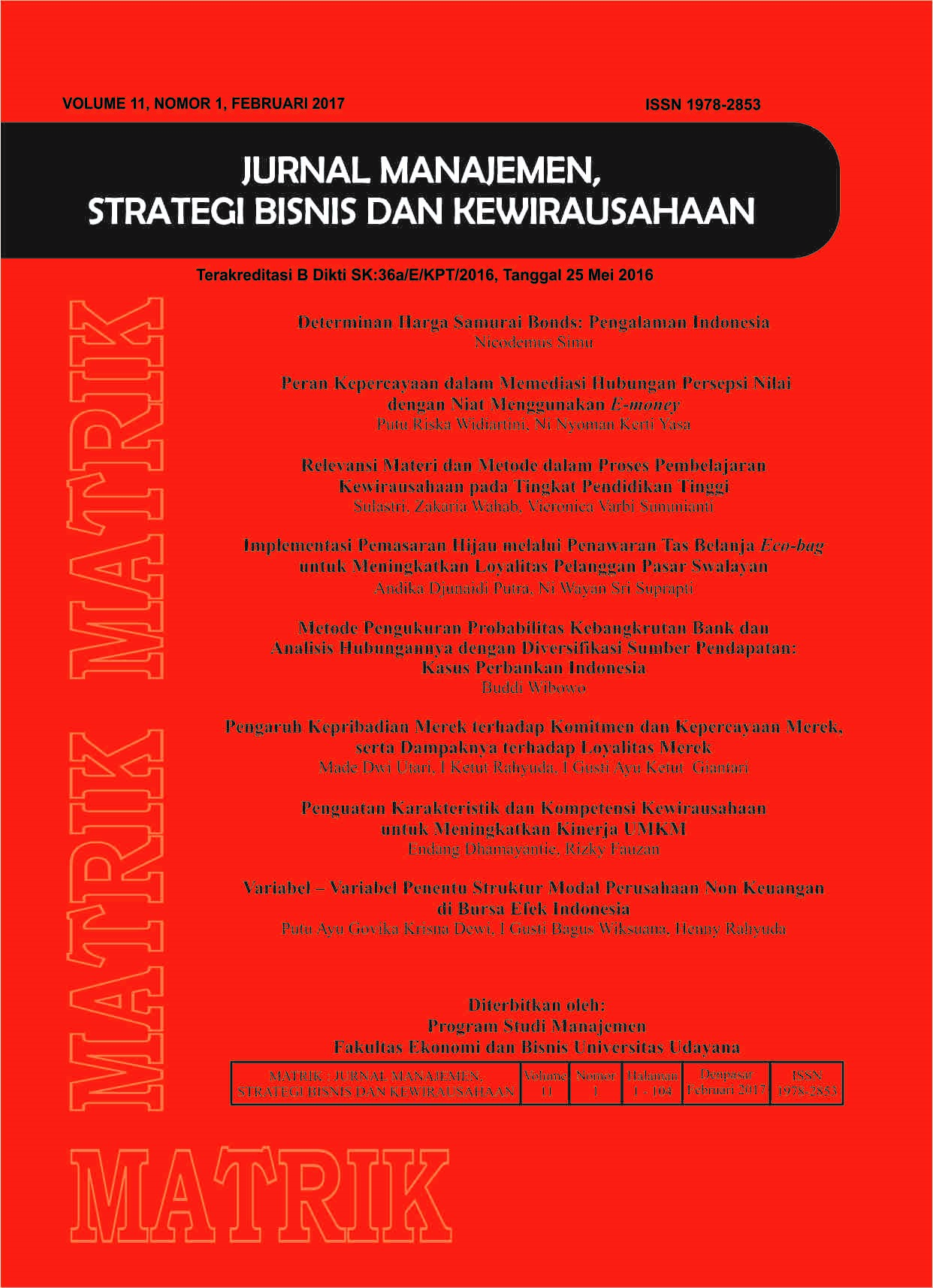RELEVANSI MATERI DAN METODE DALAM PROSES PEMBELAJARAN KEWIRAUSAHAAN PADA TINGKAT PENDIDIKAN TINGGI
Abstract
ABSTRACT
Entrepreneurship program has become a national policy that is believed to be a tool to reduce unemployment and poverty. Therefore, entrepreneurship has become a national curriculum in almost every study program and has incorporated entrepreneurship module as one of the subjects in achieving learning outcome and graduate profile. The terms in entrepreneurship are also growing, with the aim of establishing a social construction towards the understanding of entrepreneurship as a science, which contains elements of knowledge, skills and attitudes. Besides, entrepreneurship construct that need to be built in the learning process is very complex and involves multiple disciplines, so it is important to study empirically the relevancy between learning materials and methods in entrepreneurship learning process in higher education.
This study aims to examine whether there are differences in the learning materials and methods in entrepreneurial learning at higher education level. The research is carried out in several public and private universities with a sample of 304 students from some courses both for the field of sciences and social studies that have entrepreneurship as one of their taught modules.
It can be concluded that entrepreneurial learning materials can be grouped in the aspect of (1) knowledge; (2) skills and (3) attitude. In each aspect, the learning materials are collected and grouped and observed on itslearning methodology. The results by using Anova testing show that there are differences in some teaching materials and learning methods in the same faculty or inter- faculty at several universities. Furthermore, in the cognitive construction of the entrepreneurship metaphor (innovation, creative, proactive and risk -taking), it is found that it has not been delivered usingrelevant learning methods, as well as learning models of personal development.
Downloads
References
Alvarez and Barney. 2007. Discovery and Creation: Alternative Theories of Entrepreneurial Action. Strategic Enterpreneurship Journal, 1(1-2): 11-26.
Cardow A. 2006. The Metaphorical Rise of Entrepreneurship. Departement of Management and International Business Research Working Paper Series 2006, no 8. Auckland, NZ: Massey University, Departement of Management and International Business
Chen David D (2003), A Classification System for Metaphors About Teaching, Journal of Physical Education Recreation & Dane; Feb 2003, 7,2; Proquest Research Library pg 24
Chi-Kim, C. (2008). Entrepreneurship education in hong kong's secondary curriculum. Education & Training, 50(6), 500-515. doi:http://dx.doi.org/10.1108/00400910810901827
Collins, L. A., Smith, A. J., & Hannon, P. D. (2006). Applying a synergistic learning approach in entrepreneurship education. Management Learning, 37(3), 335-354. Retrieved from http://search.proquest.com/docview/209878380?accountid=31434
Corbett, A. C. (2002). Opportunity recognition: A learning and cognitive approach. (Order No. 3074731, University of Colorado at Boulder). ProQuest Dissertations and Theses, , 185-185 p. Retrieved from http://search.proquest.com/docview/304798207?accountid=31434. (304798207).
Dugassa, T. G. (2012). The context of entrepreneurship education in ethiopian universities. Management Research Review, 35(3), 225-244. doi:http://dx.doi.org/10.1108/01409171211210136
Ehiobuche, C., Tu, H., & Justus, B. (2012). Dialogue As A Tool For Teaching And Learning Of Entrepreneurship.Retrieved from http://search.proquest.com
Garud, R. and Ktha, S. “Using the Brain as a Metaphor to Model Flexible Productive Units,”Academy ofmanagement review (19).1994, pp.671-698.
Hedner, T. (2011, How to implement an innovation and entrepreneurship curriculum. Global Focus, 5, 28-31.
Higgins, V., J. Dibden, and C.Cocklin. 2012. Market instruments and the neoliberalisation of land management in rural Australia. Geoforum 43: 377-386.
Huebscher, J., & Lendner, C. (2010). Effects of entrepreneurship simulation game seminars on entrepreneurs' and students' learning. Journal of Small Business and Entrepreneurship, 23(4), 543-554,649
Kirby, D. A. (2004). Entrepreneurship education: Can business schools meet the challenge? Education & Training, 46(8), 510-519.
Koning, Alice de., Dodd, Sarah D. 2008. Metaphors of Entrepreneurship Across Cultures, Journal of Asia Entrepreneurship and Sustainability, Page 88 Refered Edition, Vol IV, Issue 2, October 1988: Conference Issues” Persepectives On Entrepreneurship”
Krathwohl . David R. (2002), A Revision of Bloom’s Taxonomy: An Overview (2002) Theory Into Practice, Volume 41, Number 4, Autumn 2002 Copyright C) 2002 College of Education, The Ohio State University
Laukkanen Mauri, 2003, Exploring academic entrepreneurship: drivers and tensions of university-based business, Journal Of Small Business and Enterprise Development; 10,4; ABI/INFORM Research
Leach, E. (2007). Instruction-based action guidelines built on bloom's revised framework: Setting objectives for entrepreneurship teaching. Journal of Small Business and Entrepreneurship, 20(4), 351-358,360-368,439.
Leitch, C. M., & Harrison, R. T. (1999). A process model for entrepreneurship education and development. International Journal of Entrepreneurial Behaviour & Research, 5(3), 83-83
Lumpkin and Dess 1996, Clarifying the entrepreneurial orientation construct and linking it to performance , Academy of Management Review, 2(1): 135-172
Mccourt, W.: 1997, “Discussion Note:Using Metaphors to Understand and to Change Organizations: A Critique Of Gareth Morgan’s Approach”, Organization Studies 18(3), 511-522.
McMullen, J.S., & Shepherd, D.A. (2006), Entrepreneurial action and role of uncertainty in the theory of the entrepreneur. Academy of Management Review, 31(1): 132-
Miller, D., & Friesen, P. N. Archetypes of strategy formation. Management Science, 1978,24,921-933.
Morris, M., (1998) Entrepreneurial Intensity. Westport. Quorum performance: a configurational approach. Journal of Business Venturing. 20(1):71-91 Pitt 1998
Oluniyi, O., & Obembe, O. B. (2012). Promoting entrepreneurship skill through constructivist based model of curriculum development in social studies. Journal of Asia Entrepreneurship and Sustainability, 8(1), 143-159.
Parris, J. B. (2002). High school entrepreneurship education: A comparison of a traditional teacher-led learning model with a computer-supported collaborative learning model. (Order No. 3067299, The University of Alabama). Retrieved from http://search.proquest.com
Pitt,M., & Sims, D. (1998). Preparing For novel situations: Evoking managerial role identities. Journal of management education, 22(6),682-706. Retrieved From http:/search.prowuest.com/docview/195751880?accountid=31434.
Rocha, H. and J. Brikinshaw: 2007, “ Enterpreneuship safari a phenomenon-driven search for meaning”, Foundations and trends in enterpreneuship 3, 205-255
Rushworth, S. (2013). Entrepreneurship Education: The Case For Adopting The Team-Based Learning Approach. Journal of Asia Entrepreneurship and Sustainability, 9(1), 14-38.
Schumpeter, J. (1911/1934) The Theory of Economic Development. Cambridge, MA: Harvard University Press.
Segal, G., Schoenfeld, J., & Borgia, D. (2007). Which Classroom-Related Activities Enhance Students' Entrepreneurial Interests And Goals?: A Social Cognitive Career Theory Perspective. Academy of Entrepreneurship Journal, 13(2), 79-98.
Seikkula-Leino, J. (2008). Implementing entrepreneurship education through curriculum reform. Paper presented at the 1-24.
Siok, S. T., & Ng, C. K. F. (2006). A problem-based learning approach to entrepreneurship education. Education & Training, 48(6), 416-428. doi:http://dx.doi.org/10.1108/00400910610692606
St-jean, E., & Audet, J. (2012). The role of mentoring in the learning development of the novice entrepreneur. International Entrepreneurship and Management Journal, 8(1), 119-140. doi:http://dx.doi.org/10.1007/s11365-009-0130-7
Timmons,J. A., & Spinelli.S., Jr. (2004), New Vensure creation: Entrepreneurship for the 21si century, Boston:McGraw.Hill/Irwin.
Vesper, K. (1990) New Venture Strategies. Englewood Cliffs.Prentice Hall
Wiklund, J., (1999) The Sustainability Of The Entrepreneurial Orientation—Performance Relationship Entrepreneurship: Theory and Pratice InfoTrac OneFile. Thomson Gale. Massey university Library.
Wiklund, J., and Shepherd, D. (2005) Entrepreneurial orientalition and small business
Witkin. H.A., Moore, C.A., Oltman, P.K., Gooddenough, D.R, Friedman, F., Owen, D.R. et al (1977). Role of the field dependent and field independent cognitive styles in academic evolution: A longitudinal study, Journal of Educational Psychology, 69(3), 197-211, `doi:10.1037/0022.0663.69.3.197.
Keywords
 This work is licensed under a Creative Commons Attribution-ShareAlike 4.0 International License.
This work is licensed under a Creative Commons Attribution-ShareAlike 4.0 International License.



















